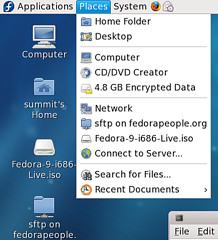
- Image by redhatmag via Flickr
No matter how much we learn, there is always more we can learn. We hate to be regurgitating comments to our own blog posts, but we continue to admit it when we’ve learned something new. But another comment from the head of the Fedora Project prompted us to write this post, on how to get a copy of Fedora if we’ve sold you on the idea of trying it out.
If you aren’t certain whether you want to install Fedora to a computer, you can try a Live CD. Fedora comes in two basic flavors(until the next version, where there will be a change in architectures). A 32-bit and a 64-bit version. We use the 64-bit version, as our processors can handle it. You may need to check. 64-bit only comes into play if you have more than 3.5GB of RAM, but if your processor can handle it, why not use the version that matches your computer?
In addition to the OS installation DVDs, you can get a Live CD which will launch a fully operational version of Fedora off a CD, or install that image to a USB drive so your settings will be saved in between boots. The basic version is a standard desktop which can be used to install the base operating system, after which the remaining packages you want will be installed and downloaded. This is also the design Ubuntu offers.
The nice thing about Live CDs is that you can test drive the OS without committing to it. The standard Live CD,called the Desktop Edition uses Gnome as its default desktop. Fedora offers an alternate KDE Live CD. It also offers some custom spins, which is defined as “a community release that has been created using one of the Fedora remixing tools, preferably either Pungi (regular images) or livecd-creator (Live CD/DVD’s). Custom spins should be strict subset’s of packages available in the official Fedora repositories.” Which means no official spins which add MP3 or DVD codecs can be hosted by Fedora. Current official Spins include:
- XFCE – A version of the Fedora Desktop Live CD that uses XFCE as the desktop instead of Gnome or KDE
- BROFFICE – Fedora will have for the first time the BrOffice.org brand for the office suite. This spin is intended to be a Brazilian Portuguese localized spin that provides the legal brand for OpenOffice.org in Brazil.
- FEL – Fedora Electronic Lab, a high-end hardware design and simulation platform. This platform provides different hardware design flows based on the semiconductor industry’s current trend. FEL maps in new design, simulation and verification methodologies with opensource EDA software.
- DEVELOPER – Live DVD jam-packed with various development applications, such as Eclipse, Anjuta, git, cvs, lynx, emacs, and a hex editor; and build tools like GCC, Inkscape, Koji, createrepo, mock, rpmdevtools, rpmlint and much more.
- AOS – A JeOS spin for building pre-installed, pre-configured, system images. The Spin consists of a small set of packages upon which the appliance building tools can be used. The spin is part of the Appliance Tools feature. This feature consists of a tools and meta-data that make it easier for anyone (ISVs, developers, OEMS, etc) to create and deploy virtual appliances.
- EDU-MATH – Educational spin tailored toward mathematics and scientific applications
- GAMES – A LiveCD with a showcase of games from Fedora. Here’s a list of included games.
Fedora offers direct download of ISOs, torrents, and Jigdo. We mentioned Jigdo in a previous post. It is a JIGsaw DOwnloader. It takes RPM package files and assembles them into an install image. We had wondered why the custom spins and Live CDs are not offered this way, and had sent several emails asking, with no response, till the Head of the Fedora Project(maybe we should name him a Gadget Wisdom correspondent) came back with this answer.
Jeroen van Meeuwen from our Spins SIG was kind enough to send me this information on Jigdo:
“The jigdo method of distribution basically works as follows: for every file in a .iso that you tell jigdo is available from somewhere else, it strips the file (or slice, or piece of the .iso jigsaw) from the .iso leaving you with a relatively small .iso.template (only the parts of the .iso that are not available from somewhere else) and a list of files you can get from somewhere else.
“Now, with installation media, this means there’s a small part of the .iso you need to download in the form of a .iso.template, while the rest (install.img, and all RPMs) is available from any mirror (and you are going to use the closest and fastest one).
“With Live media however, the contents of the .iso is just a few files. Some of them are really small (vmlinuz0, initrd0.img), while others are very large and make up 99% of the size of the .iso (osmin.img and squashfs.img). Splitting those slices from the .iso isn’t very useful, because you would end up downloading a small .iso.template, several very small files, and then one single beast of a file (squashfs.img).â€
Hopefully this helps clarify our jigdo availability. Thanks for the question!
So, our assumption that this would be helpful was incorrect, and we learned something new. We look forward to sharing other things we don’t know as we share and enhance our Fedora knowledge.
And for the Fedora Project…give it a shot. You certainly have a lot of ways to experience it, from full immersion to merely dipping your toes in. Hmm…maybe we should become a Fedora Ambassador, although we have yet to get someone to switch to Fedora for good. We came rather close with one person, but he fell off the wagon and went back to Microsoft.
Related articles by Zemanta
- Best Operating System Live CDs and DVDs (livecrunch.com)
- Five Best Live CDs (lifehacker.com)

![Reblog this post [with Zemanta]](http://img.zemanta.com/reblog_e.png?x-id=bbccdbe4-582e-4e5a-9e02-dd017945e782)